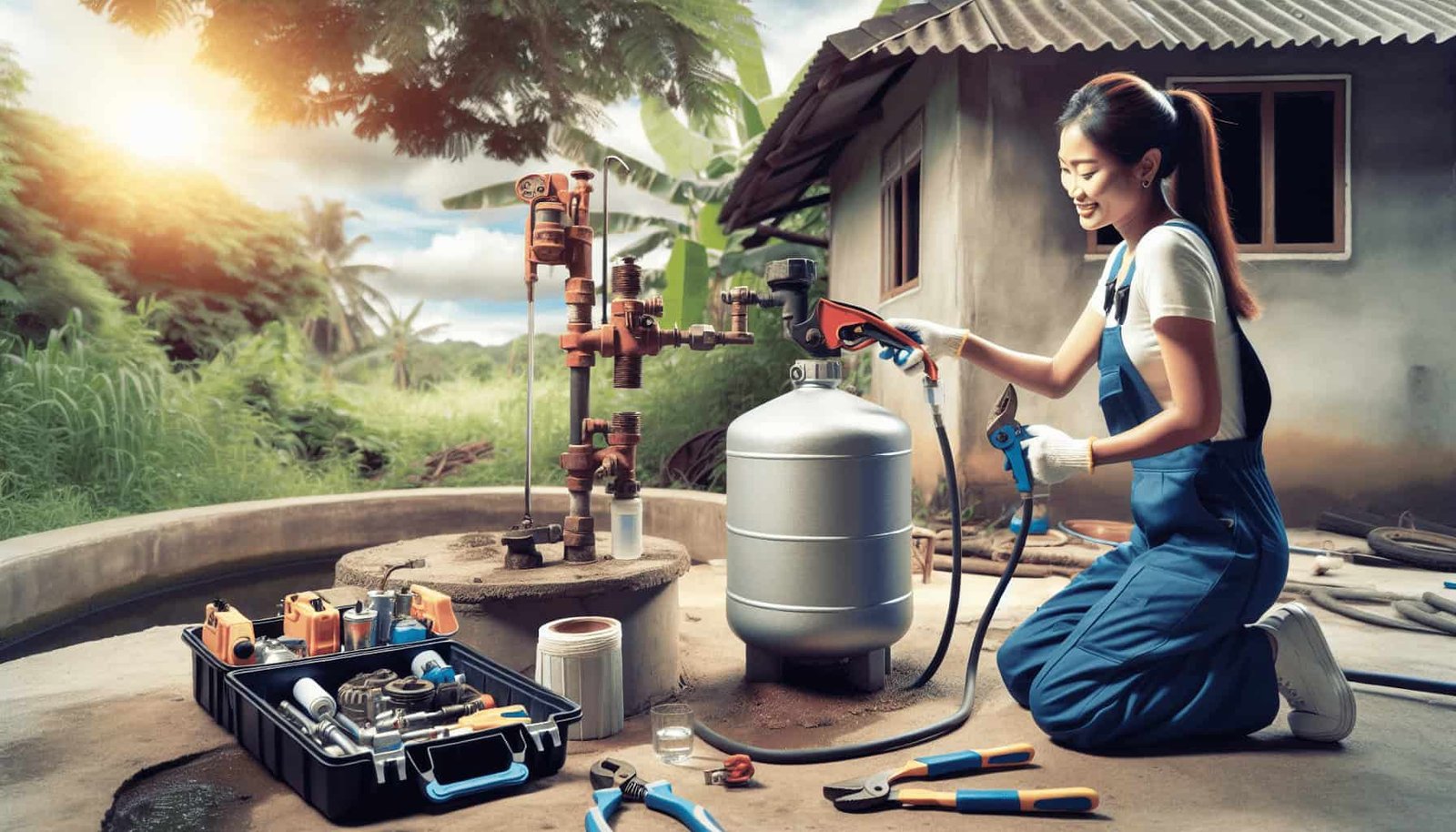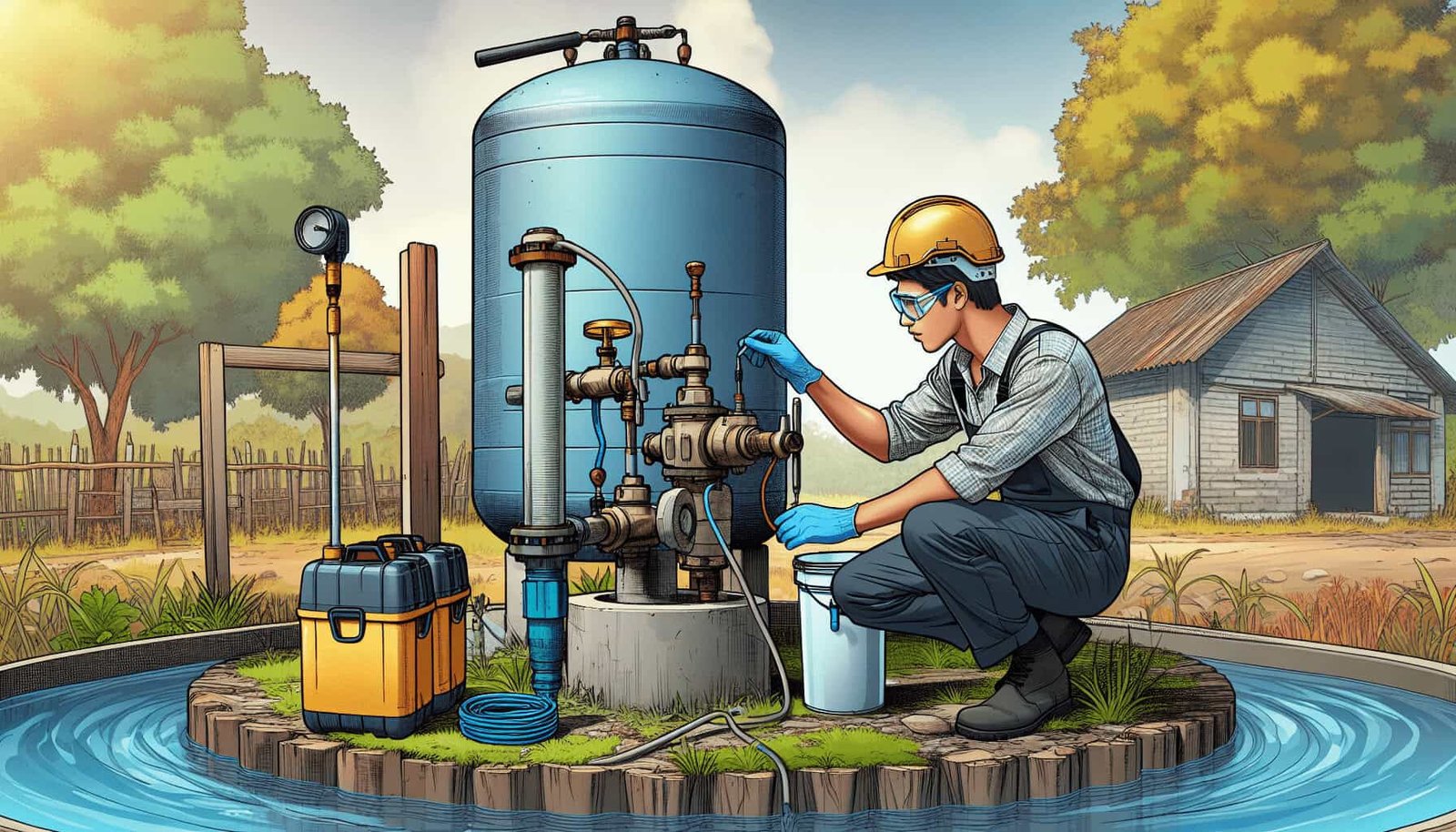In the quest for well water safety, it becomes crucial to understand the measures required in regions with well water pressure tank maintenance programs. You may wonder, how can I ensure the safety of my well water in such areas? Well, fret not, as this article aims to provide you with valuable insights and tips to guarantee the well-being and purity of your well water.

Understanding Well Water Pressure Tank Maintenance Programs
Purpose of well water pressure tank maintenance programs
Well water pressure tank maintenance programs are designed to ensure the proper functioning and longevity of well water systems. These programs aim to prevent any issues that may arise from a malfunctioning pressure tank, including decreased water pressure, system failures, and potential health hazards. By implementing regular maintenance procedures, well owners can proactively address any potential problems and maintain the safety and efficiency of their well water system.
Benefits of well water pressure tank maintenance programs
Participating in a well water pressure tank maintenance program offers numerous benefits for well owners. Firstly, it helps to extend the lifespan of the pressure tank by identifying and addressing any issues early on, preventing the need for costly repairs or replacements. Additionally, regular maintenance can improve water pressure consistency, ensuring a reliable supply of clean water for household needs. Moreover, a well-maintained pressure tank reduces the risk of contamination and improves water quality, promoting the health and well-being of residents.
Common practices in well water pressure tank maintenance programs
Well water pressure tank maintenance programs typically include several common practices to ensure the proper functioning of the pressure tank. Regular inspections are conducted to identify any signs of malfunction, such as leaks, pressure fluctuations, or unusual noises. Additionally, well owners should schedule routine servicing, including cleaning, disinfection, and testing of the pressure tank. Regular maintenance also involves checking and adjusting the tank’s air pressure, as improper pressure levels can lead to issues with water flow and system efficiency.
Assessing Potential Threats to Well Water Safety
Identifying contaminants in well water
To ensure well water safety, it is essential to identify any potential contaminants that may be present in the water supply. These contaminants can include bacteria, viruses, chemicals, and minerals that may pose health risks if consumed or exposed to. Common contaminants found in well water include coliform bacteria, nitrates, arsenic, lead, and pesticides. Well owners should consider conducting regular water testing to assess the quality of their well water and identify any potential threats to safety.
Determining potential sources of contamination
Understanding the potential sources of contamination is crucial for maintaining well water safety. These sources can vary depending on the location and surrounding environment. Common sources of contamination include nearby septic systems, agricultural runoff, industrial activities, and natural geological formations that may contain harmful minerals. Evaluating the proximity and conditions of these potential sources can help well owners implement preventive measures and minimize the risk of contamination.
Understanding the risks associated with untreated well water
Untreated well water poses several risks to human health. Contaminants present in untreated well water can lead to various waterborne illnesses, including gastrointestinal issues, respiratory problems, and skin irritations. Furthermore, long-term exposure to certain contaminants, such as arsenic or lead, can have serious health consequences, including increased cancer risks and neurological disorders. It is crucial for well owners to understand the potential risks associated with untreated well water to prioritize the safety of their water supply.
Importance of Regular Monitoring and Testing
Frequency of well water testing
Regular monitoring and testing of well water is essential to ensure its safety and quality. The frequency of testing can vary depending on several factors, including local regulations, well characteristics, and potential sources of contamination. In general, it is recommended to test well water at least once a year for common contaminants. However, certain situations may require more frequent testing, such as experiencing changes in water taste, odor, color, or quality, or when there are known incidents of contamination in the area.
Parameters to test for in well water
Well water testing should cover a range of parameters to assess its quality and safety. These parameters typically include testing for bacteria, such as coliform bacteria and E. coli, which indicate the presence of fecal contamination. Additionally, testing for nitrates, arsenic, lead, pesticides, and other potentially harmful chemicals is crucial. Depending on the local regulations and specific concerns of the area, well owners may need to test for additional parameters, such as radon, fluoride, or volatile organic compounds (VOCs).
Interpreting test results and taking necessary actions
Interpreting well water test results is a vital step in ensuring its safety. Well owners should review the test results carefully and compare them to the recommended safe levels established by regulatory agencies. If any parameter exceeds the acceptable limits, immediate actions should be taken to address the issue. This may involve implementing treatment systems, repairing the well, or consulting with water quality professionals for guidance. Regularly monitoring and interpreting test results allow well owners to promptly respond to any potential threats to their well water safety.
Maintaining Well Water Pressure Tanks for Safety
Signs of a malfunctioning pressure tank
Recognizing the signs of a malfunctioning pressure tank is crucial to maintain the safety and efficiency of the well water system. Some common signs of a malfunctioning pressure tank include frequent cycling of the pump, rapid fluctuations in water pressure, water hammering noises, decreased water flow, or the presence of air or water leaks near the pressure tank. If any of these signs are noticed, it is important to address the issue promptly to prevent further damage to the pressure tank and potential health risks.
Importance of proper installation and maintenance
Proper installation and regular maintenance are key factors in ensuring the safety and longevity of well water pressure tanks. Well owners should ensure that their pressure tank is installed according to manufacturer guidelines and local regulations. This includes proper electrical grounding, correct pipe size, and appropriate placement of pressure switches and safety valves. Regular maintenance, such as cleaning, inspecting for any corrosion or damage, and adjusting the air pressure as needed, helps to prevent malfunctions and extend the lifespan of the pressure tank.
Scheduling routine inspections and servicing
Well owners should establish a routine schedule for professional inspections and servicing of their pressure tank. These routine inspections, typically conducted by certified professionals, involve a comprehensive check of the pressure tank, including its components, electrical connections, pressure settings, and overall condition. Additionally, routine servicing may involve cleaning and disinfection of the pressure tank to remove any accumulated sediment or biofilm. Maintaining a regular inspection and servicing schedule helps to identify and address any potential issues before they escalate into more significant problems.

Implementing Preventive Measures
Ensuring proper well construction and location
Ensuring proper well construction and location is a vital preventive measure to maintain well water safety. Well construction should follow local regulations and guidelines to minimize the risk of contamination. This includes adequate well head protection, proper grouting, and sealing of well casing to prevent the entry of surface water or contaminants. Additionally, careful consideration of the well location, such as distancing from potential sources of contamination like septic systems or chemical storage areas, can reduce the likelihood of well water contamination.
Installing effective filtration systems
Installing effective filtration systems is an important preventive measure for well water safety. Filtration systems can remove or reduce various contaminants, such as sediment, bacteria, viruses, chemicals, and minerals, ensuring the delivery of clean and safe drinking water. Well owners should select filtration systems based on the specific contaminants present in their well water. Common filtration systems used in well water include activated carbon filters, reverse osmosis systems, and ultraviolet (UV) disinfection units. Regular maintenance and replacement of filters are necessary to ensure the continued effectiveness of the filtration system.
Using disinfection methods to eliminate harmful pathogens
Disinfection methods are essential in eliminating harmful pathogens in well water and preventing waterborne illnesses. Chlorination is a widely used disinfection method that effectively kills bacteria and viruses in well water. Well owners can use chlorine tablets, liquid solutions, or chlorine injection systems to disinfect their well water. It is important to follow proper dosing and contact time guidelines to ensure effective disinfection without compromising the water quality. Regularly monitoring and maintaining appropriate disinfection levels help to ensure the safety of the well water supply.
Educating Well Owners About Safety Measures
Providing information on well water safety precautions
Education is crucial in promoting well water safety among well owners. Providing well owners with information on well water safety precautions can empower them to take the necessary steps to maintain a safe and clean water supply. This may include guidelines on regular maintenance, testing protocols, proper disinfection methods, understanding potential sources of contamination, and the importance of professional inspections. Well owners should be aware of potential risks and be equipped with knowledge on how to address and prevent them.
Promoting awareness of potential risks
Raising awareness about the potential risks associated with untreated well water is important in motivating well owners to prioritize well water safety. Well owners should be educated about the health hazards posed by various contaminants found in well water and the potential consequences of long-term exposure. Sharing case studies, statistics, and real-life examples can help illustrate the importance of maintaining a safe well water supply. Continuous campaigns and outreach programs can significantly contribute to increasing awareness and fostering a proactive approach towards well water safety.
Encouraging participation in well water safety programs
Encouraging well owners to participate in well water safety programs can provide them with additional resources and support. These programs may offer educational workshops, training sessions, access to testing facilities, or discounted servicing for pressure tanks. Participating in such programs not only helps well owners stay informed and up-to-date on best practices but also demonstrates their commitment to maintaining a safe water supply for themselves and their community. Collaboration with local authorities and organizations can facilitate the establishment and promotion of these well water safety programs.

Dealing with Emergency Situations
Steps to take in case of a water quality emergency
In the event of a water quality emergency, swift action is necessary to ensure the safety of the well water supply. Well owners should immediately cease using water from the well and switch to an alternate source of water until the issue is resolved. The next step involves identifying the cause of the emergency, such as a sudden increase in contaminants or a malfunctioning pressure tank. This may require contacting water quality professionals or relevant authorities. Once the cause is identified, appropriate remedial measures should be taken to rectify the issue and restore the well water to a safe and reliable state.
Contacting relevant authorities for guidance
In emergency situations or when facing significant water quality issues, well owners should not hesitate to contact relevant authorities for guidance and support. Local health departments, environmental agencies, or water quality organizations can provide valuable assistance in dealing with water quality emergencies. These authorities can provide guidance on emergency actions, recommend appropriate testing or treatment options, and ensure regulatory compliance. Contacting the authorities promptly can help in effectively addressing the emergency and protecting the well water supply.
Temporary solutions for ensuring safe water supply
While addressing a water quality emergency, it is important to ensure a temporary supply of safe water. Well owners can implement temporary solutions like using bottled water, utilizing water filtration pitchers, or installing point-of-use water filters that are certified to remove specific contaminants. These temporary solutions can provide immediate access to clean drinking water until the underlying issues with the well water supply are resolved. It is essential to follow the manufacturer’s instructions and regularly monitor and maintain these temporary solutions for ongoing water safety.
Navigating Regulations and Compliance
Understanding local laws and regulations
Navigating local laws and regulations is crucial for well owners to ensure compliance and maintain the safety of their well water supply. Different regions may have specific requirements and standards regarding well construction, water testing, and reporting. Well owners should familiarize themselves with these regulations and stay updated on any changes or revisions. This ensures that their well water system meets the necessary standards for safety and quality, as well as mitigates the risk of potential legal consequences.
Complying with testing and reporting requirements
Complying with testing and reporting requirements is an important aspect of ensuring well water safety. Local authorities may have specific testing frequencies, parameters, and reporting procedures that well owners must adhere to. Regular testing, accurate recording of test results, and timely reporting of any issues or incidents help demonstrate compliance and accountability in maintaining a safe well water supply. Well owners should be diligent in meeting these requirements and seek assistance from certified professionals when necessary.
Seeking assistance from certified professionals
Well owners should not hesitate to seek assistance from certified professionals when navigating regulations or addressing complex water quality issues. Certified professionals, such as water quality specialists, hydrogeologists, or licensed well drillers, possess the necessary expertise and knowledge to guide well owners through regulations and compliance. These professionals can provide insights into best practices, assist with testing and analysis, recommend appropriate treatment systems, and offer tailored solutions to address specific challenges. Collaborating with certified professionals ensures well owners receive accurate information and reliable support.

Collaborating with Well Water Pressure Tank Maintenance Programs
Benefits of participating in maintenance programs
Participating in well water pressure tank maintenance programs offers numerous benefits for well owners. These programs provide an opportunity to access professional services and expertise in maintaining pressure tanks and ensuring the overall safety and efficiency of the well water system. Regular inspections, servicing, and preventive maintenance can help prevent costly repairs, extend the lifespan of the pressure tank, and ensure consistent water pressure. Additionally, participating in maintenance programs demonstrates a commitment to well water safety and responsible water management.
Demonstrating commitment to well water safety
By actively participating in well water pressure tank maintenance programs, well owners demonstrate their commitment to ensuring the safety and quality of their well water supply. Regular maintenance and adherence to recommended guidelines reflect responsible water stewardship and a proactive approach towards protecting the well water. Moreover, well owners who actively engage in maintenance programs set an example for their community, encouraging others to prioritize well water safety and consider joining similar initiatives.
Accessing resources and support for well owners
Well water pressure tank maintenance programs often offer additional resources and support to well owners. These resources may include educational materials, training sessions, access to testing facilities, or discounts on servicing and maintenance. Participating in these programs allows well owners to stay informed on the latest industry practices, address any concerns or questions, and receive guidance from professionals. The support provided by these programs can empower well owners to confidently maintain their well water systems and protect the health and well-being of themselves and their families.
Promoting Public Health and Well Water Safety
Challenges to public health in regions with well water
Regions with well water face unique challenges when it comes to public health. As individuals rely on private wells for their water supply, ensuring the safety and quality of well water becomes a shared responsibility. Challenges include potential contamination from nearby sources, the presence of naturally occurring contaminants, lack of access to regulated water systems, and the potential for inadequate maintenance or testing. Addressing these challenges requires collaborative efforts from well owners, communities, and relevant authorities to promote public health and well water safety.
Developing community initiatives for well water safety
Community initiatives are vital in promoting well water safety and fostering a culture of responsible water management. These initiatives can involve collaboration between well owners, local organizations, health departments, and water quality agencies. Community workshops, awareness campaigns, and educational programs can provide valuable information on best practices for well water safety, proper maintenance, and testing protocols. Encouraging well owners to share their experiences, challenges, and success stories can create a supportive network and inspire others to prioritize well water safety.
Sharing success stories and lessons learned
Sharing success stories and lessons learned from well water pressure tank maintenance programs can encourage other well owners to follow suit and prioritize well water safety. These success stories highlight the positive outcomes achieved through regular maintenance, testing, and preventive measures. They provide real-life examples of how well owners have resolved issues, improved water quality, and safeguarded the health of their families. Sharing these experiences reinforces the importance of well water safety and motivates others to take action in maintaining a safe and reliable well water supply.
In conclusion, ensuring well water safety in regions with well water pressure tank maintenance programs requires a comprehensive approach. By understanding the purpose and benefits of maintenance programs, assessing potential threats to well water safety, implementing preventive measures, educating well owners about safety measures, and collaborating with relevant programs, the overall public health and well-being can be safeguarded. Regular monitoring, testing, proper maintenance, and compliance with regulations contribute to creating a culture of responsible well water management. Together, well owners and communities can promote well water safety, protect public health, and share the success stories of maintaining a safe and clean well water supply.

